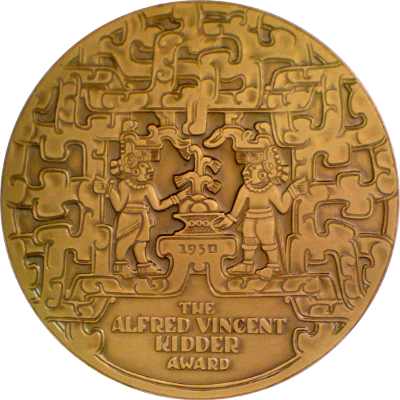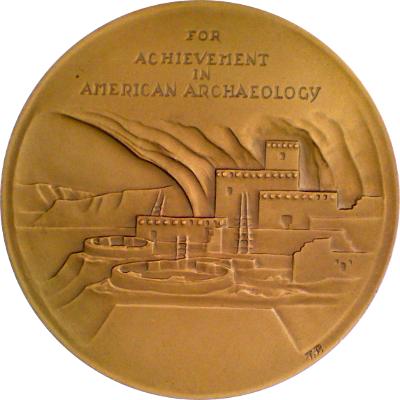Artist Name
You can click medals to switch between obverse and reverse sides.


The medal's obverse bears a classic Mayan motif of two priests at an altar. Incuse on altar, 1950; In exergue, THE / ALFRED VINCENT / KIDDER / AWARD
The reverse shows a Southwestern pueblo under cliff or in cave, maybe Mesa Verde. Above, FOR / ACHIEVEMENT / IN / AMERICAN ARCHAEOLOGY; signed T.P. along rim in lower right.
The edge is marked at 12:00, ROBBINS CO. ATTLEBORO / GENUINE BRONZE
Alfred Vincent Kidder (October 29, 1885 – June 11, 1963) was an American archaeologist considered the foremost of the southwestern United States and Mesoamerica during the first half of the 20th century. He saw a disciplined system of archaeological techniques as a means to extend the principles of anthropology into the prehistoric past and so was the originator of the first comprehensive, systematic approach to North American archaeology.
Established in 1950, the Alfred Vincent Kidder Award for Eminence in the Field of American Archaeology was given every three years to an outstanding archaeologist specializing in the archaeology of the Americas. The award has been given alternately to specialists in Mesoamerican archaeology and the archaeology of the Southwestern region &emdash; areas that were both central to the pioneering and exemplary work of A. V. Kidder.
This award, presented by the AAA but selected by the Archaeology Division of AAA, is now given every two years.
The medal expresses the two different archeaological areas of interest through the imagery on the two sides, both of which were designed by Tatiana Proskouriakoff (1909-1985). She not only designed the medal but was also the award's fifth recipient. The Mayan motif on the obverse represents the Mesoamerican area, whereas the pueblo scene on the reverse represents the Northamerican Southwest.
The medal measures 76mm (3in) in diameter and was struck in bronze by the Robbins Company of Attleboro, Massachusetts.